Preparation and Characterization of Electrospun PAN/PSA Carbonized Nanofibers: Experiment and Simulation Study
Abstract
1. Introduction
2. Experiment and Simulation
2.1. Experimental Materials
2.2. Fabrication of PAN/PSA Carbonized Nanofibers
2.3. Characterization
2.3.1. Scanning Electron Microscopy
2.3.2. Fourier-Transform Infrared Spectroscopy
2.3.3. Thermal Analysis
2.3.4. Electrical Conductivity
2.4. Electric Field Simulation
3. Results and Discussion
3.1. Simulation Results and Analysis
3.1.1. Effect of Needle Size on Electric Field
3.1.2. Effect of Spinning Voltage on Electric Field
3.1.3. Effect of Receiving Distance on Electric Field
3.2. Chemical Structure of Samples
3.3. Surface Morphology
3.4. Thermal Stability
3.5. Electrical Conductivity
4. Conclusions
Author Contributions
Funding
Acknowledgments
Conflicts of Interest
References
- Wu, T.; Zhang, J.L.; Wang, Y.F.; Sun, B.B.; Guo, X.R.; Morsi, Y.; Elhamshary, H.; Elnewehy, M.; Mo, X.M. Development of dynamic liquid and conjugated electrospun poly(l-lactide-co-caprolactone)/collagen nanoyarns for regulating vascular smooth muscle cells growth. J. Biomed. Nanotechnol. 2017, 13, 303–312. [Google Scholar] [CrossRef] [PubMed]
- Yu, Y.; Huang, Q.Y.; Niu, L.Y.; Wang, D.R.; Yan, C.; She, Y.Y.; Zheng, Z.J. Waterproof, ultrahigh areal-capacitance, wearable supercapacitor fabrics. Adv. Mater. 2017, 29, 1606679. [Google Scholar]
- Zhang, Y.; Wang, L.; Guo, Z.Y.; Xu, Y.F.; Wang, Y.G.; Peng, H.S. High-performance lithium-air battery with a coaxial-fiber architecture. Angew. Chem. Int. Ed. 2016, 128, 4563–4567. [Google Scholar] [CrossRef]
- Zhou, G.Y.; Xiong, T.R.; Jiang, S.H.; Jian, S.Y.; Zhou, Z.P.; Hou, H.Q. Flexible titanium carbide–carbon nanofibers with high modulus and high conductivity by electrospinning. Mater. Lett. 2016, 165, 91–94. [Google Scholar] [CrossRef]
- Li, J.N.; Jing, P.P.; Zhang, X.L.; Cao, D.R.; Wei, J.W.; Pan, L.N.; Liu, Z.L.; Wang, J.B.; Liu, Q.F. Synthesis, characterization and magnetic properties of NiFe2−xCexO4 nanoribbons by electrospinning. J. Magn. Magn. Mater. 2017, 425, 37–42. [Google Scholar] [CrossRef]
- Wang, X.F.; Iqbal, N.; Yu, J.Y.; Jabeen, N.; Wazir, H.U.; Ding, B. In-situ synthesis of carbon nanotubes doped metal-organic frame work for CO2 capture. RSC Adv. 2015, 6, 4382–4386. [Google Scholar]
- He, J.X.; Lian, Y.P.; Zhang, X.L.; Wu, Y.C.; Liu, R.T. Mass preparation of nanofibers by high pressure air-jet split electrospinning: Effect of electric field. J. Polym. Sci. Part B Polym. Phys. 2014, 52, 993–1001. [Google Scholar] [CrossRef]
- Vysloužilová, L.; Buzgo, M.; Pokorný, P.; Chvojka, J.; Míčková, A.; Rampichová, M.; Kula, J.; Pejchar, K.; Bílek, M.; Lukáš, D. Needleless coaxial electrospinning: A novel approach to mass production of coaxial nanofibers. Int. J. Pharm. 2017, 516, 293–300. [Google Scholar] [CrossRef] [PubMed]
- Kim, M.H.; Lee, W.J.; Lee, D.H.; Ko, S.W.; Hwang, T.I.; Kim, J.W.; Park, C.H.; Kim, C.S. Development of nanofiber reinforced double layered cabin air filter using novel upward mass production electrospinning set up. J. Nanosci. Nanotechnol. 2018, 18, 2132–2136. [Google Scholar] [CrossRef] [PubMed]
- Huan, S.Q.; Liu, G.X.; Han, G.P.; Cheng, W.L.; Fu, Z.Y.; Wu, Q.L.; Wang, Q.W. Effect of experimental parameters on morphological, mechanical and hydrophobic properties of electrospun polystyrene fibers. Materials 2015, 8, 2718–2734. [Google Scholar] [CrossRef]
- Lasprilla-Botero, J.; Álvarez-Láinez, M.; Lagaron, J.M. The influence of electrospinning parameters and solvent selection on the morphology and diameter of polyimide nanofibers. Mater. Today. Commun. 2018, 14, 1–9. [Google Scholar] [CrossRef]
- Casasola, R.; Thomas, N.L.; Trybala, A.; Georgiadou, S. Electrospun poly lactic acid (PLA) fibres: Effect of different solvent systems on fibre morphology and diameter. Polymer 2014, 55, 4728–4737. [Google Scholar] [CrossRef]
- Anis, S.F.; Hashaikeh, R. Electrospun zeolite-Y fibers: Fabrication and morphology analysis. Microporous Mesoporous. Mater. 2016, 233, 78–86. [Google Scholar] [CrossRef]
- Baqeri, M.; Abolhasani, M.M.; Mozdianfard, M.R.; Guo, Q.; Oroumei, A.; Naebe, M. Influence of processing conditions on polymorphic behavior, crystallinity, and morphology of electrospun poly(VInylidene fluoride) nanofibers. J. Appl. Polym. Sci. 2015, 132. [Google Scholar] [CrossRef]
- Zheng, Y.S.; Meng, N.; Xin, B.J. Effects of jet path on electrospun polystyrene fibers. Polymers 2018, 10, 842. [Google Scholar] [CrossRef]
- Lai, C.C.; Lo, C.T. Effect of temperature on morphology and electrochemical capacitive properties of electrospun carbon nanofibers and nickel hydroxide composites. Electrochim. Acta 2015, 174, 806–814. [Google Scholar] [CrossRef]
- Li, W.W.; Qin, X.H. Effect of relative humidity on the morphology of electrospun gelatin aqueous solutions. Adv. Mater. Res. 2014, 941-944, 1225–1228. [Google Scholar] [CrossRef]
- Xu, H.B.; Jiang, S.H.; Ding, C.H.; Zhu, Y.M.; Li, J.J.; Hou, H.Q. High strength and high breaking load of single electrospun polyimide microfiber from water soluble precursor. Mater. Lett. 2017, 201, 82–84. [Google Scholar] [CrossRef]
- Ji, D.X.; Peng, S.J.; Lu, J.; Li, L.L.; Qin, X.H.; Yang, S.Y.; Yang, G.R.; Srinivasan, M.; Ramakrishna, S. Design and synthesis of porous channel-rich carbon nanofibers for self-standing oxygen reduction reaction and hydrogen evolution reaction bifunctional catalysts in alkaline medium. J. Mater. Chem. A 2017, 5, 7507–7515. [Google Scholar] [CrossRef]
- Jin, S.X.; Xin, B.J.; Zheng, Y.S. Preparation and characterization of polysulfone amide nanoyarns by the dynamic rotating electrospinning method. Text. Res. J. 2017. [Google Scholar] [CrossRef]
- Zeng, X.; Ou, Y.; Yang, Y.; Xian, C.; Xie, S.H. Janus-type thermoelectric Co3O4/TiO2 nanofibers by electrospinning. Nanosci. Nanotechnol. Lett. 2014, 6, 1075–1078. [Google Scholar] [CrossRef]
- Yu, D.G.; Yang, C.; Jin, M.; Williams, G.R.; Zou, H.; Wang, X.; Bligh, S.W. Medicated Janus fibers fabricated using a Teflon-coated side-by-side spinneret. Colloids Surf. B 2016, 138, 110–116. [Google Scholar] [CrossRef] [PubMed]
- Zhu, C.Q.; Deng, W.; Pan, J.Q.; Lu, B.A.; Zhang, J.W.; Su, Q.; Xie, E.Q.; Lan, W. Structure effect of dual-spinneret on the preparation of electrospun composite nanofibers with side-by-side heterojunctions. J. Mater. Sci. Mater. Electron. 2013, 24, 2287–2291. [Google Scholar] [CrossRef]
- Chen, G.Y.; Xu, Y.; Yu, D.G.; Zhang, D.F.; Chatterton, N.P.; White, K.N. Structure-tunable Janus fibers fabricated using spinnerets with varying port angles. Chem. Commun. 2015, 51, 4623–4626. [Google Scholar] [CrossRef] [PubMed]
- Peng, L.; Jiang, S.H.; Seuß, M.; Fery, A.; Lang, G.; Scheibel, T.; Agarwal, S. Two-in-one composite fibers with side-by-side arrangement of silk fibroin and poly(l-lactide) by electrospinning. Macromol. Mater. Eng. 2016, 301, 48–55. [Google Scholar] [CrossRef]
- Tong, X.; Bin-Jie, X. Preparation and characterization of polyester staple yarns nanowrapped with polysulfone amide fibers. Ind. Eng. Chem. Res. 2015, 54, 12303–12312. [Google Scholar] [CrossRef]
- Wu, K.J.; Yao, Y.B.; Yu, J.C.; Chen, S.H.; Wang, X.F.; Zhang, Y.M.; Wang, H.P. Cellulose/aromatic polysulfonamide blended fibers with improved properties. Cellulose 2017, 24, 3377–3386. [Google Scholar] [CrossRef]
- Zhang, X.S.; Tang, X.N.; Wang, R.; Wang, R.; Yan, X.; Shi, M.W. The fire retardant properties and pyrolysis mechanism of polysulfonamide (PSA) fibers. Text. Res. J. 2018, 88, 1299–1307. [Google Scholar] [CrossRef]
- Jin, S.X.; Xin, B.J.; Zheng, Y.S.; Liu, S.H. Effect of electric field on the directly electrospun nanofiber yarns: Simulation and experimental study. Fibers Polym. 2018, 19, 116–124. [Google Scholar] [CrossRef]
- Lim, B.H.; Nirmala, R.; Navamathavan, R.; Kim, H.Y. Flexible and conducting carbon nanofibers obtained from electrospun polyacrylonitrile/phosphoric acid nanofibers. J. Nanosci. Nanotechnol. 2016, 16, 1033–1037. [Google Scholar] [CrossRef] [PubMed]
- Xu, T.; Ding, Y.C.; Wang, Z.; Zhao, Y.; Wu, W.D.; Hao, F.; Zhu, Z.T. Three-dimensional and ultralight sponges with tunable conductivity assembled from electrospun nanofibers for a highly sensitive tactile pressure sensor. J. Mater. Chem. C 2017, 5, 10288–10294. [Google Scholar] [CrossRef]
- Dissanayake, M.A.K.L.; Divarathne, H.K.D.W.M.N.R.; Thotawatthage, C.A.; Dissanayake, C.B.; Senadeera, G.K.R.; Bandara, B.M.R. Dye-sensitized solar cells based on electrospun polyacrylonitrile (PAN) nanofibre membrane gel electrolyte. Electrochim. Acta 2014, 130, 76–81. [Google Scholar] [CrossRef]
- Singh, G.; Rana, D.; Matsuura, T.; Ramakrishna, S.; Narbaitz, R.M.; Tabe, S. Removal of disinfection byproducts from water by carbonized electrospun nanofibrous membranes. Sep. Purif. Technol. 2010, 74, 202–212. [Google Scholar] [CrossRef]
- Liu, H.; Cao, C.Y.; Wei, F.F.; Huang, P.P.; Sun, Y.B.; Jiang, L.; Song, W.G. Flexible macroporous carbon nanofiber film with high oil adsorption capacity. J. Mater. Chem. A 2014, 2, 3557–3562. [Google Scholar] [CrossRef]
- Efome, J.E.; Rana, D.; Matsuura, T.; Lan, C.Q. Experiment and modeling for flux and permeate concentration of heavy metal ion in adsorptive membrane filtration using a metal-organic framework incorporated nanofibrous membrane. Chem. Eng. J. 2018, 352, 737–744. [Google Scholar] [CrossRef]
- Abdalla, I.; Shen, J.L.; Yu, J.Y.; Li, Z.L.; Ding, B. Co3O4/carbon composite nanofibrous membrane enabled high-efficiency electromagnetic wave absorption. Sci. Rep. 2018, 8. [Google Scholar] [CrossRef] [PubMed]
- Zhang, L.S.; Fan, W.; Liu, T.X. Flexible hierarchical membranes of WS2 nanosheets grown on graphene-wrapped electrospun carbon nanofibers as advanced anodes for highly reversible lithium storage. Nanoscale 2016, 8, 16387–16394. [Google Scholar] [CrossRef] [PubMed]
- He, J.X.; Zhao, S.Y.; Lian, Y.P.; Zhou, M.J.; Wang, L.D.; Ding, B.; Cui, S.Z. Graphene-doped carbon/Fe3O4 porous nanofibers with hierarchical band construction as high-performance anodes for lithium-ion batteries. Electrochim. Acta 2017, 229, 306–315. [Google Scholar] [CrossRef]
- Khan, W.S.; Asmatulu, R.; Rodriguez, V.; Ceylan, M. Enhancing thermal and ionic conductivities of electrospun PAN and PMMA nanofibers by graphene nanoflake additions for battery-separator applications. Int. J. Energy. Res. 2015, 38, 2044–2051. [Google Scholar] [CrossRef]
- Mirzaei, E.; Ai, J.; Sorouri, M.; Ghanbari, H.; Verdi, J.; Faridi-Majidi, R. Functionalization of pan-based electrospun carbon nanofibers by acid oxidation: Study of structural, electrical and mechanical properties. Fullerenes Nanotubes Carbon. Nanostruct. 2015, 23, 930–937. [Google Scholar] [CrossRef]
- Elkhaldi, R.M.; Guclu, S.; Koyuncu, I. Enhancement of mechanical and physical properties of electrospun PAN nanofiber membranes using PVDF particles. Desalination Water Treat. 2016, 57, 26003–26013. [Google Scholar] [CrossRef]
- Zhang, J.J.; Wen, H.J.; Yue, L.P.; Chai, J.C.; Ma, J.; Hu, P.; Ding, G.L.; Wang, Q.F.; Liu, Z.H.; Cui, G.L.; et al. In situ formation of polysulfonamide supported poly(ethylene glycol) divinyl ether based polymer electrolyte toward monolithic sodium ion batteries. Small. 2017, 13, 1601530. [Google Scholar] [CrossRef] [PubMed]
- Ruhland, K.; Frenzel, R.; Horny, R.; Nizamutdinova, A.; Wüllen, L.V.; Moosburger-Will, J.; Horn, S. Investigation of the chemical changes during thermal treatment of polyacrylonitrile and 15N-labelled polyacrylonitrile by means of in-situ FTIR and 15N NMR spectroscopy. Polym. Degrad. Stab. 2017, 146, 298–316. [Google Scholar] [CrossRef]
- Ma, Y.N.; Zhou, T.; Su, G.H.; Li, Y.; Zhang, A.M. Understanding the crystallization behavior of polyamide 6/polyamide 66 alloys from the perspective of hydrogen bonds: Projection moving-window 2D correlation FTIR spectroscopy and the enthalpy. RSC Adv. 2016, 6, 87405–87415. [Google Scholar] [CrossRef]
- Baruah, K.; Hazarika, S.; Borthakur, S.; Dutta, N.N. Preparation and characterization of polysulfone–cyclodextrin composite nanofiltration membrane: Solvent effect. J. Appl. Polym. Sci. 2012, 125, 3888–3898. [Google Scholar] [CrossRef]

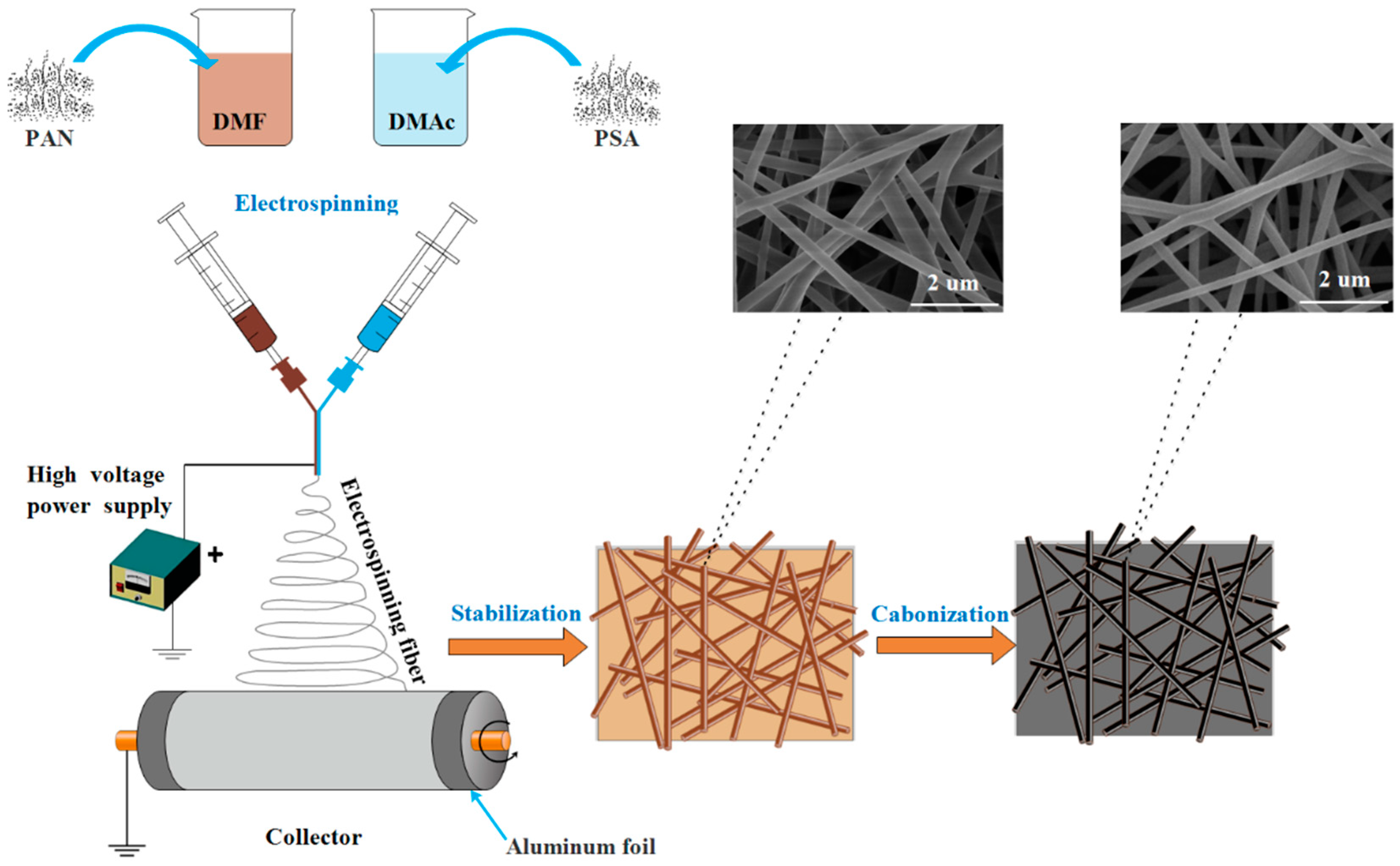
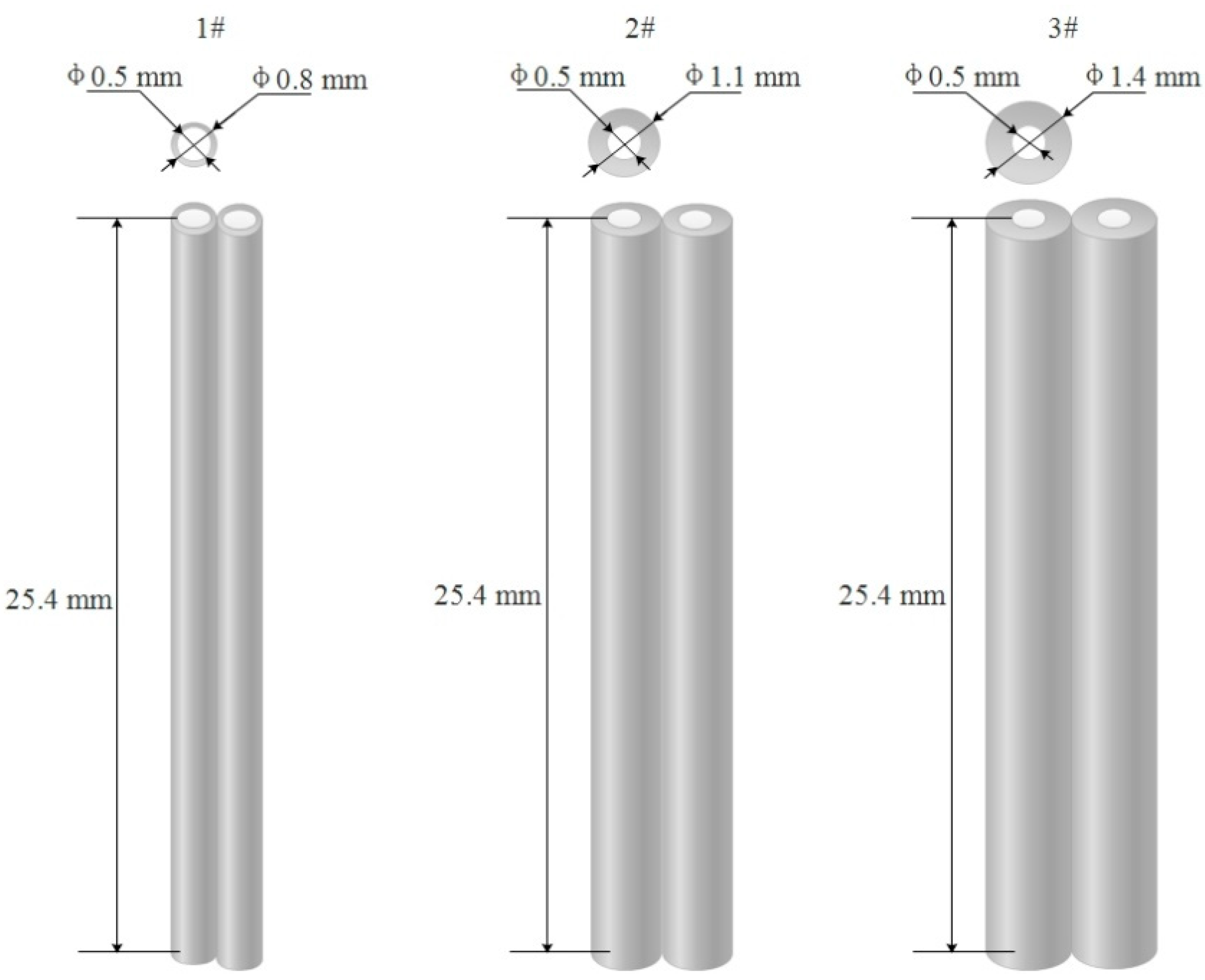
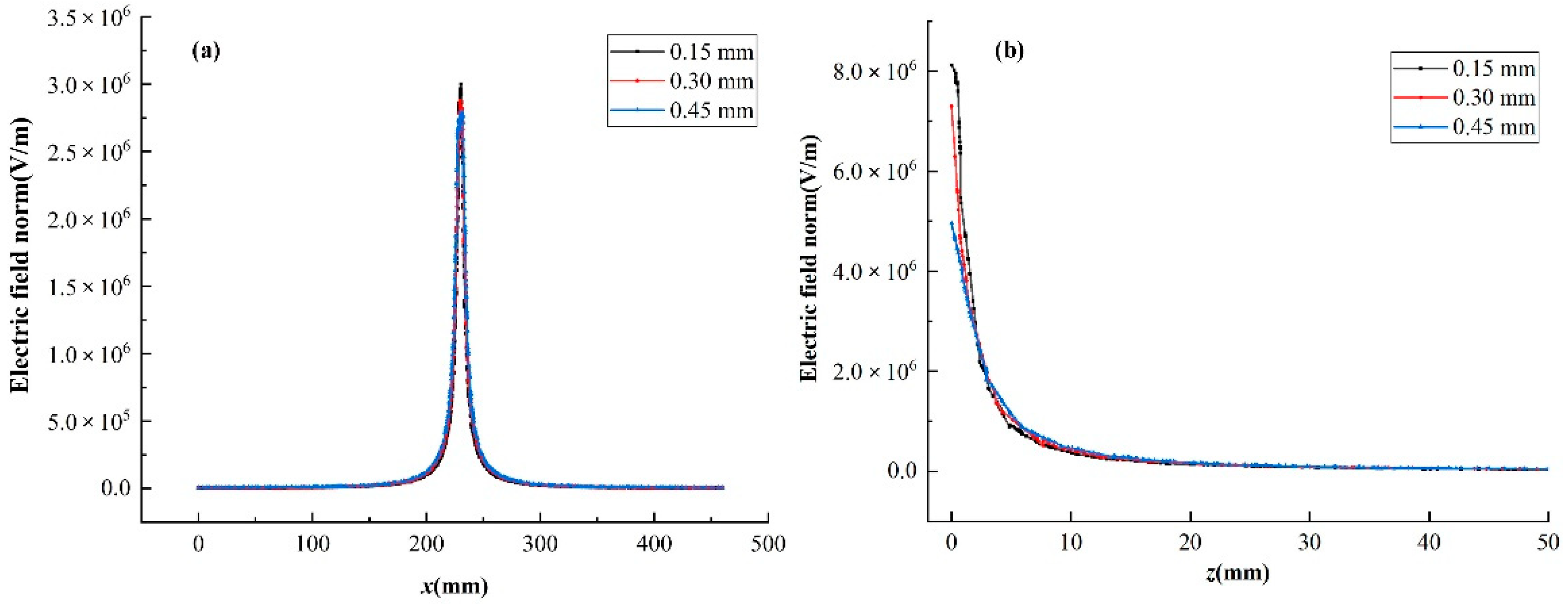

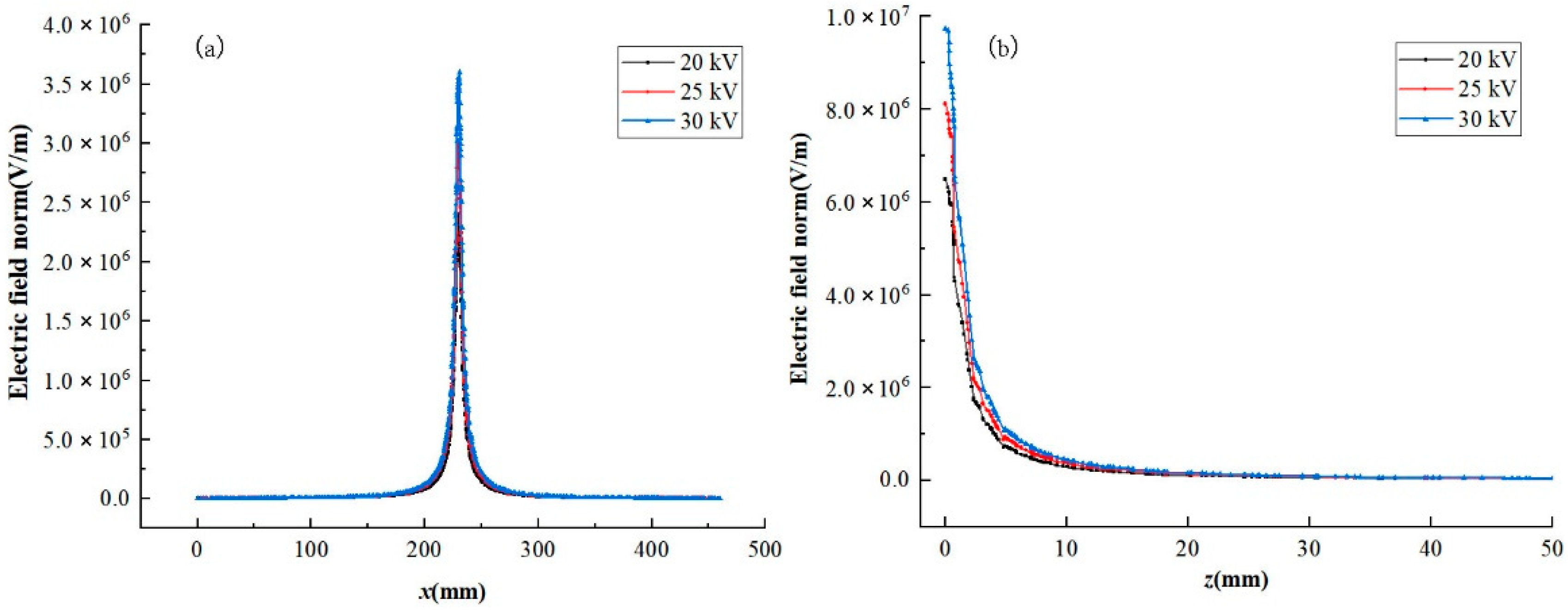

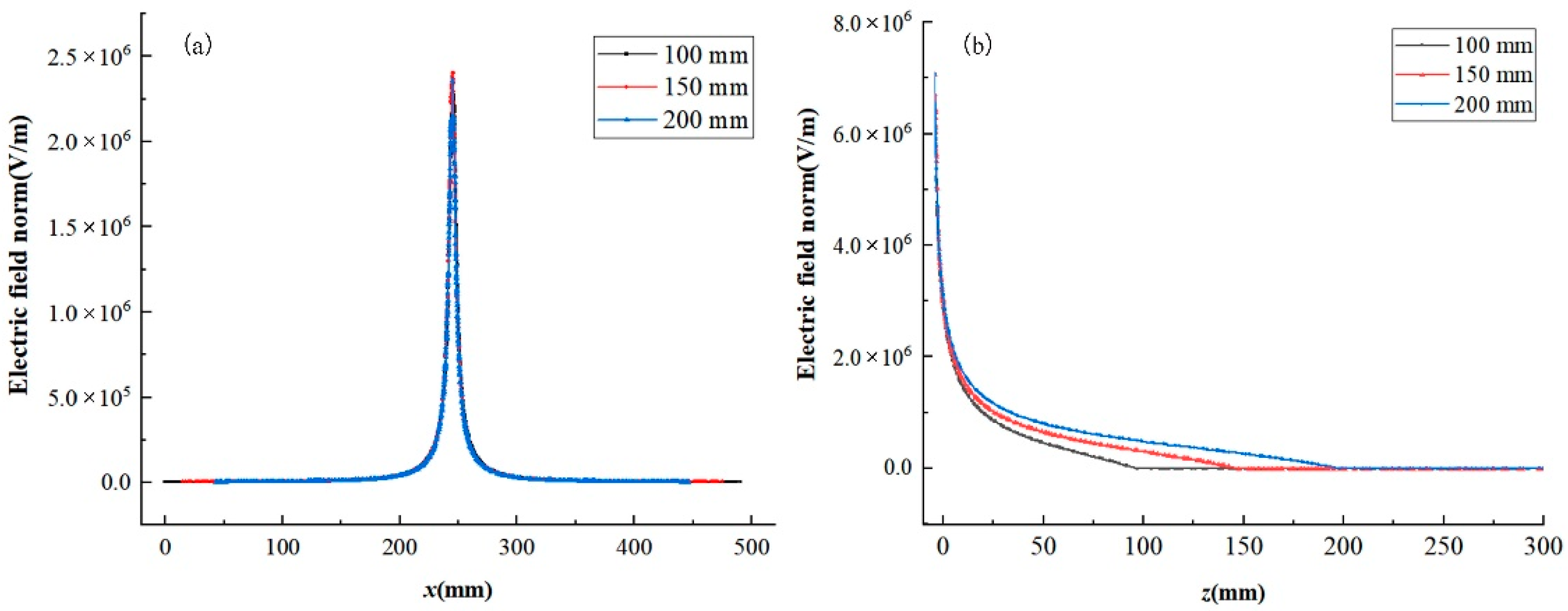
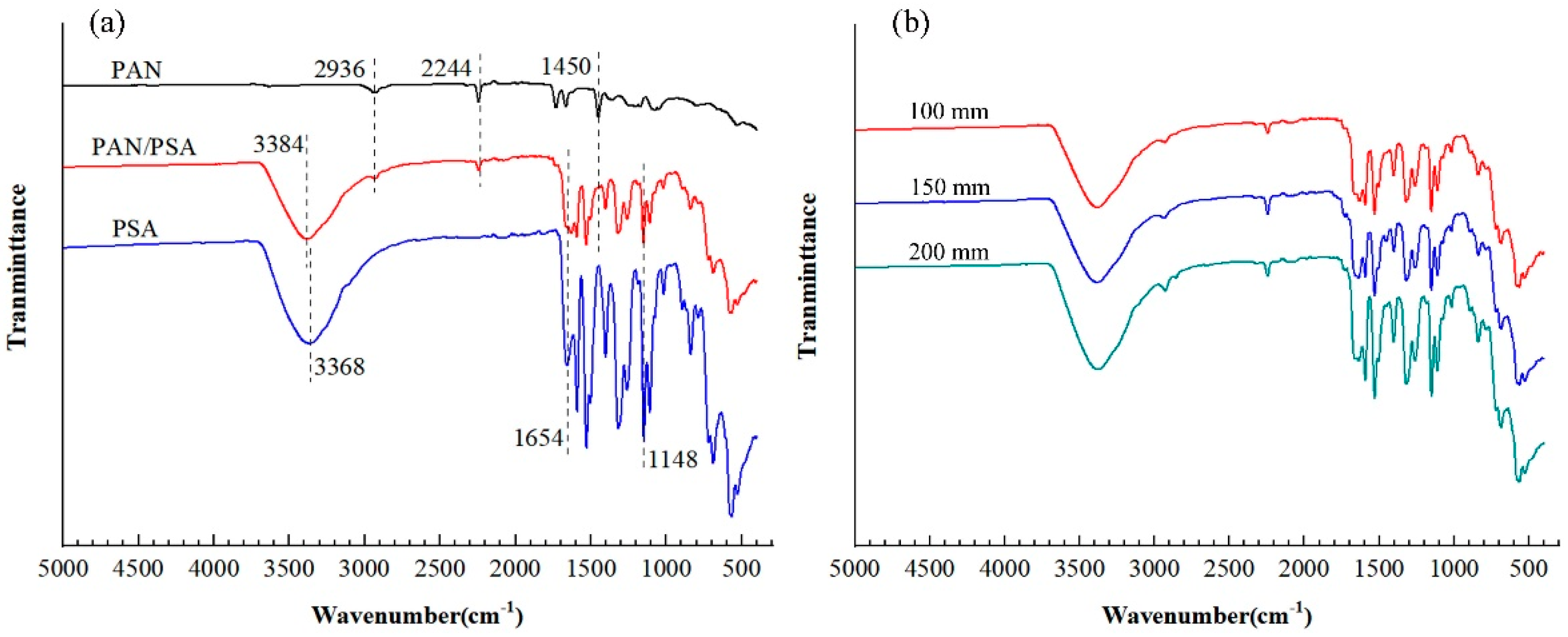
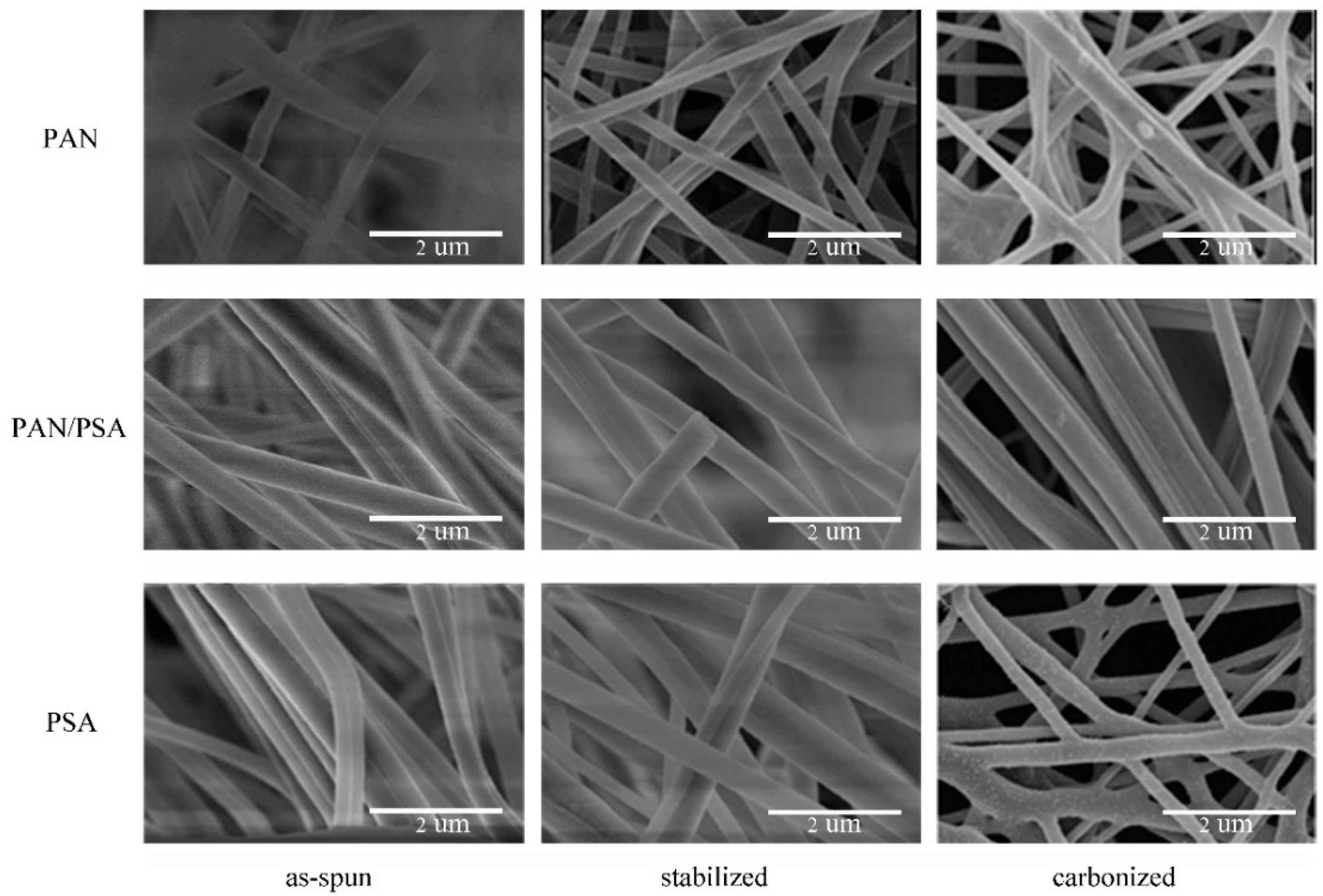

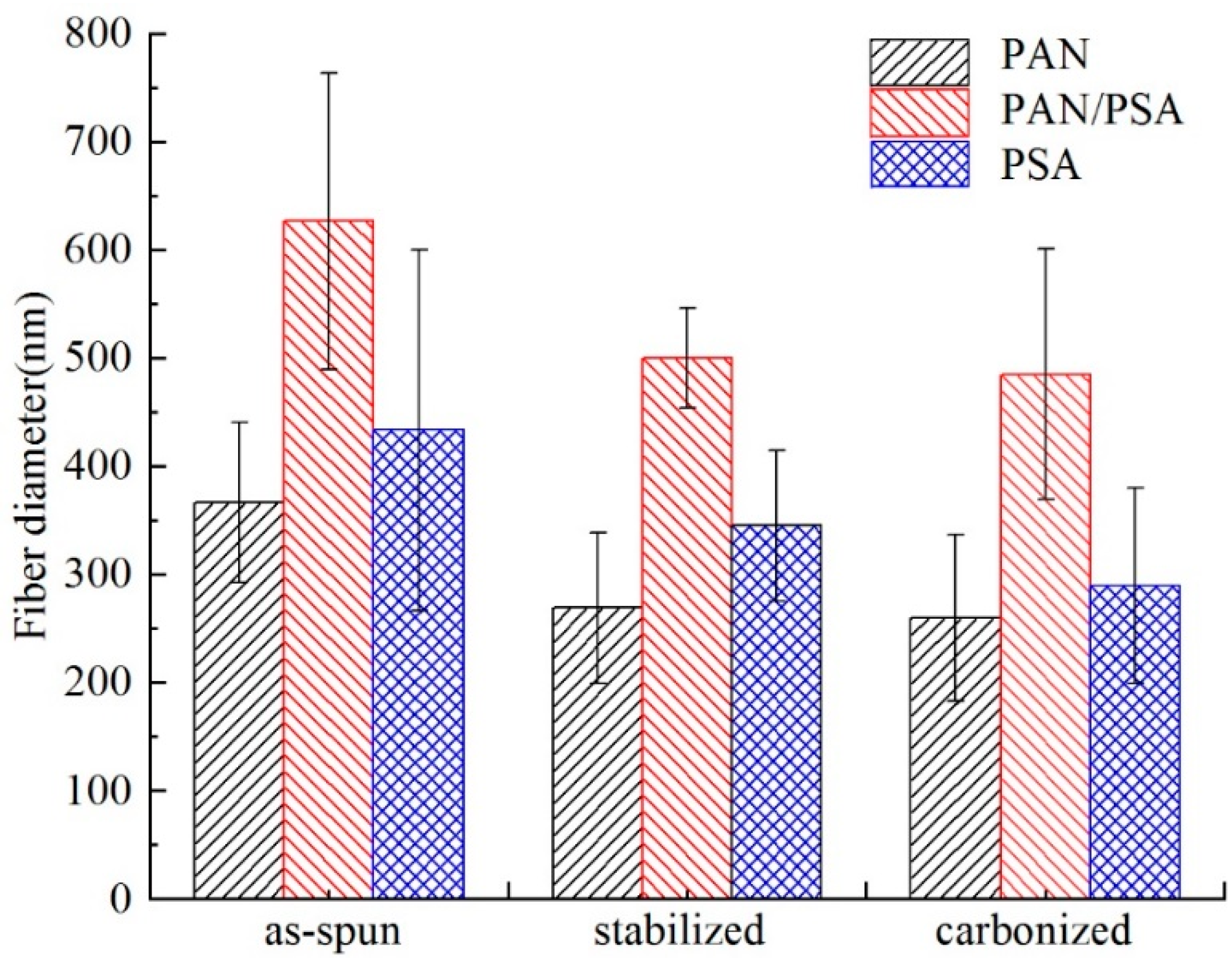
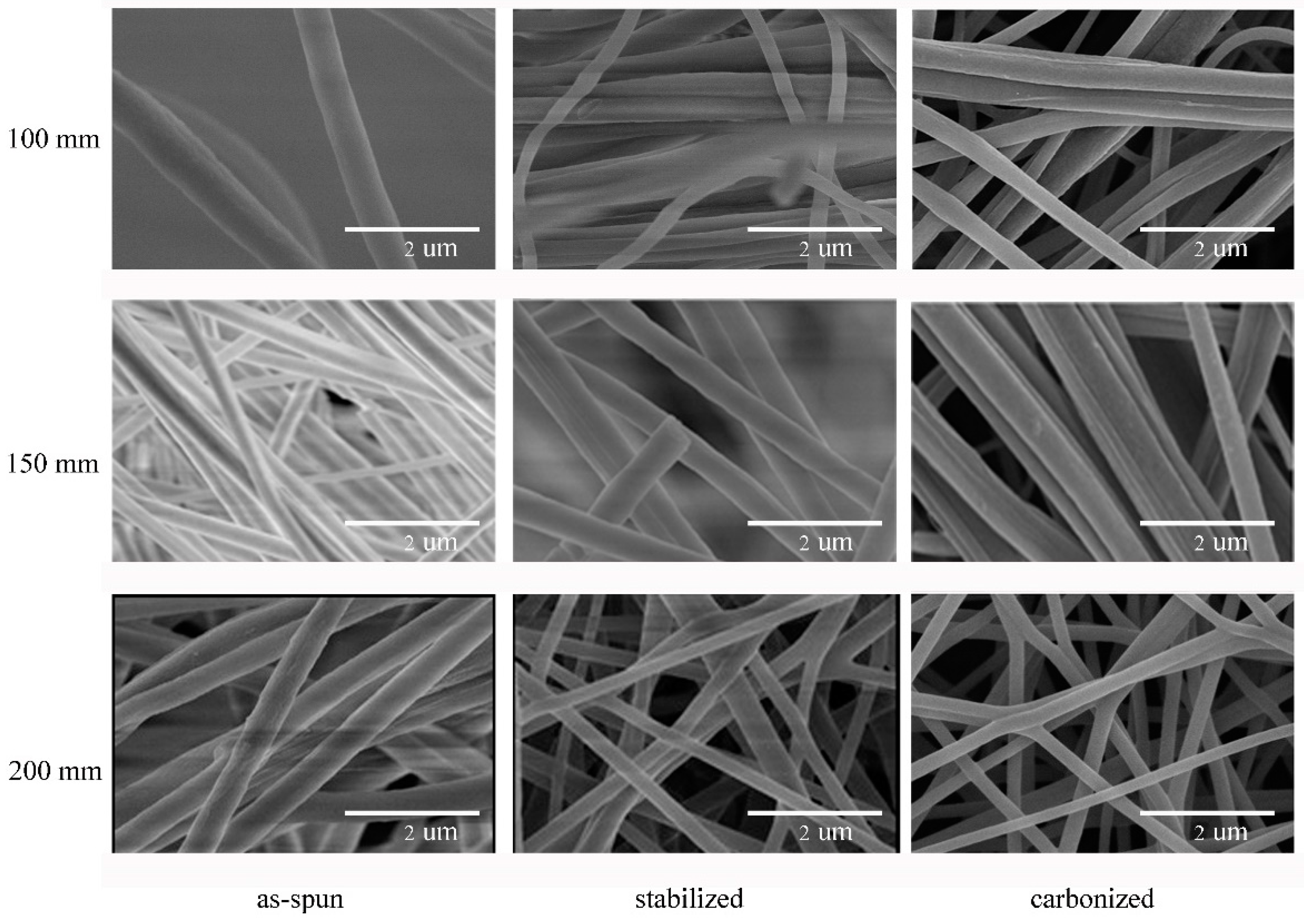

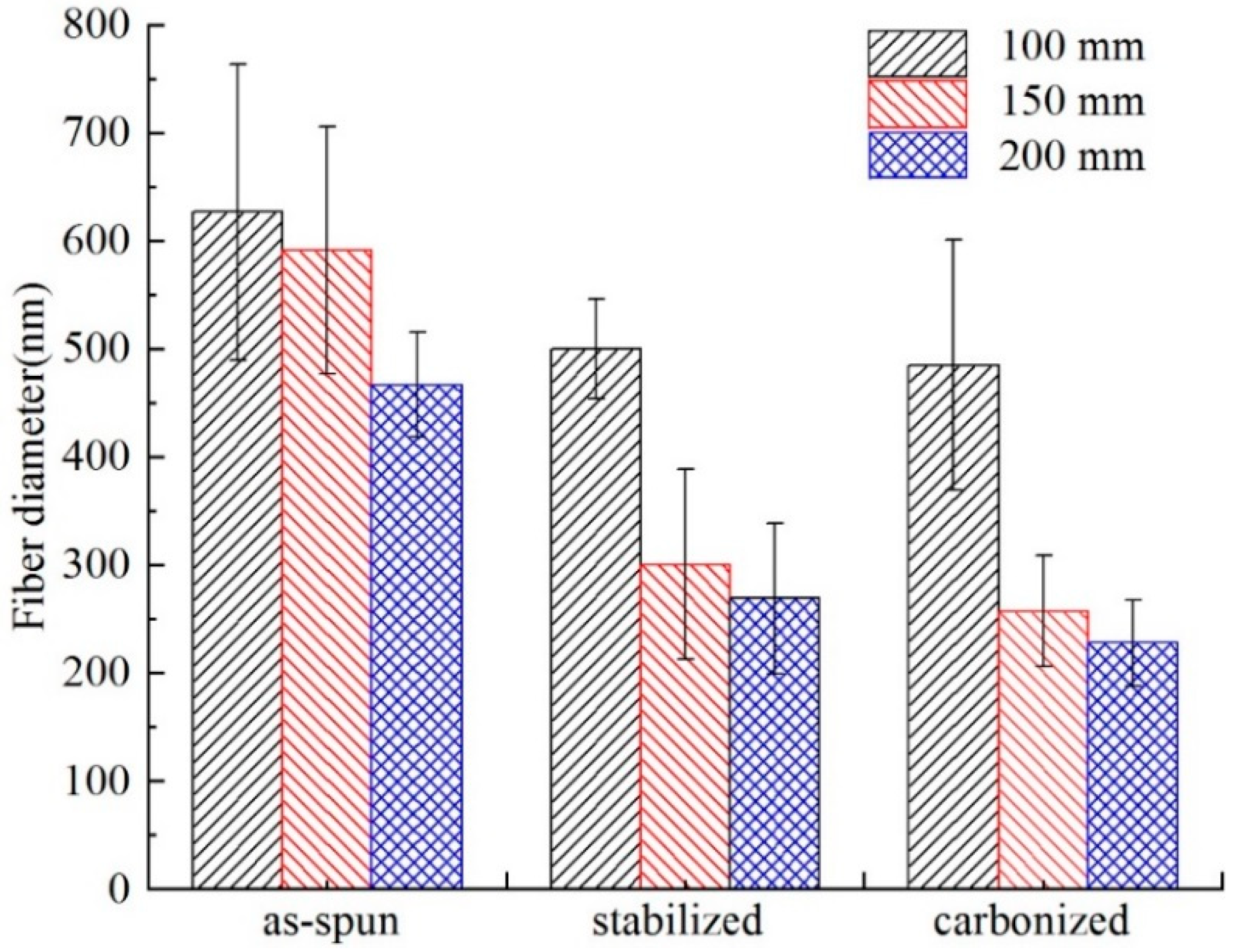
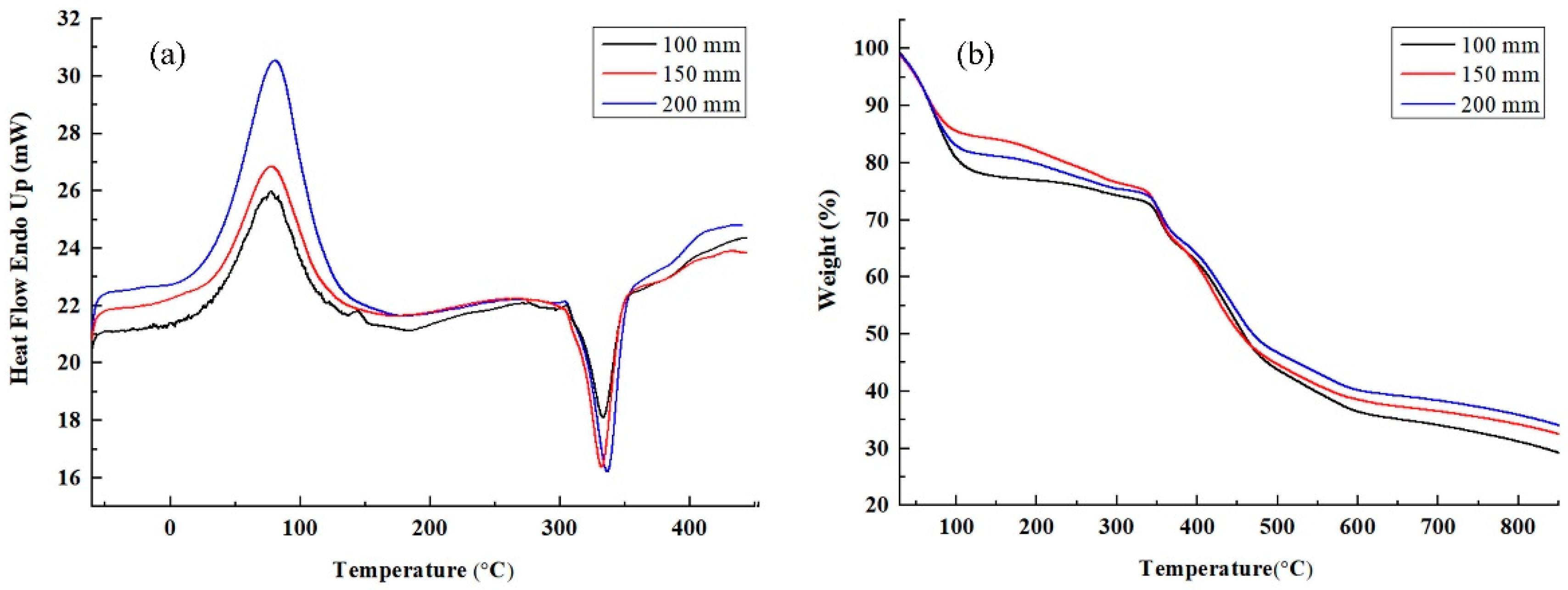
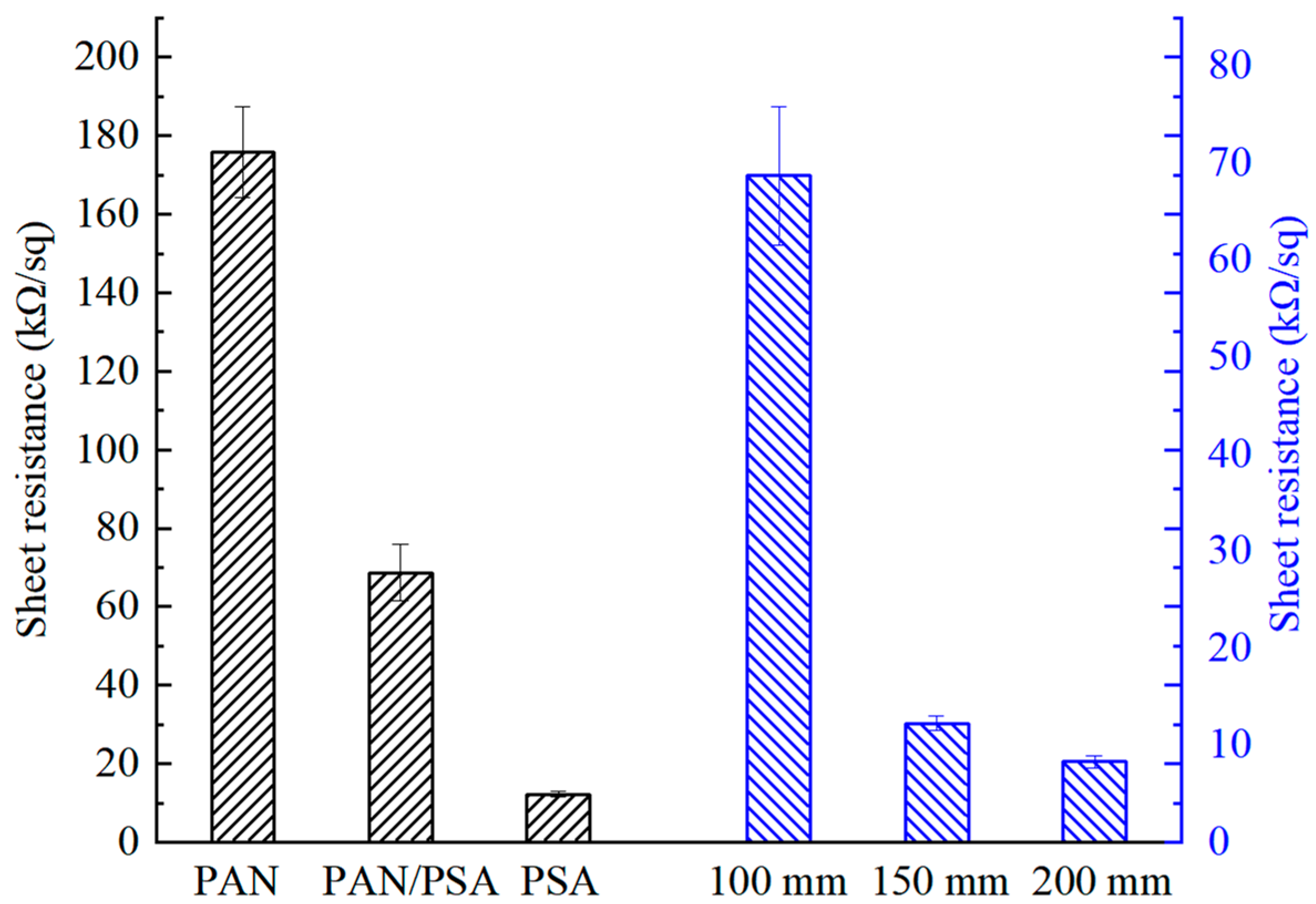
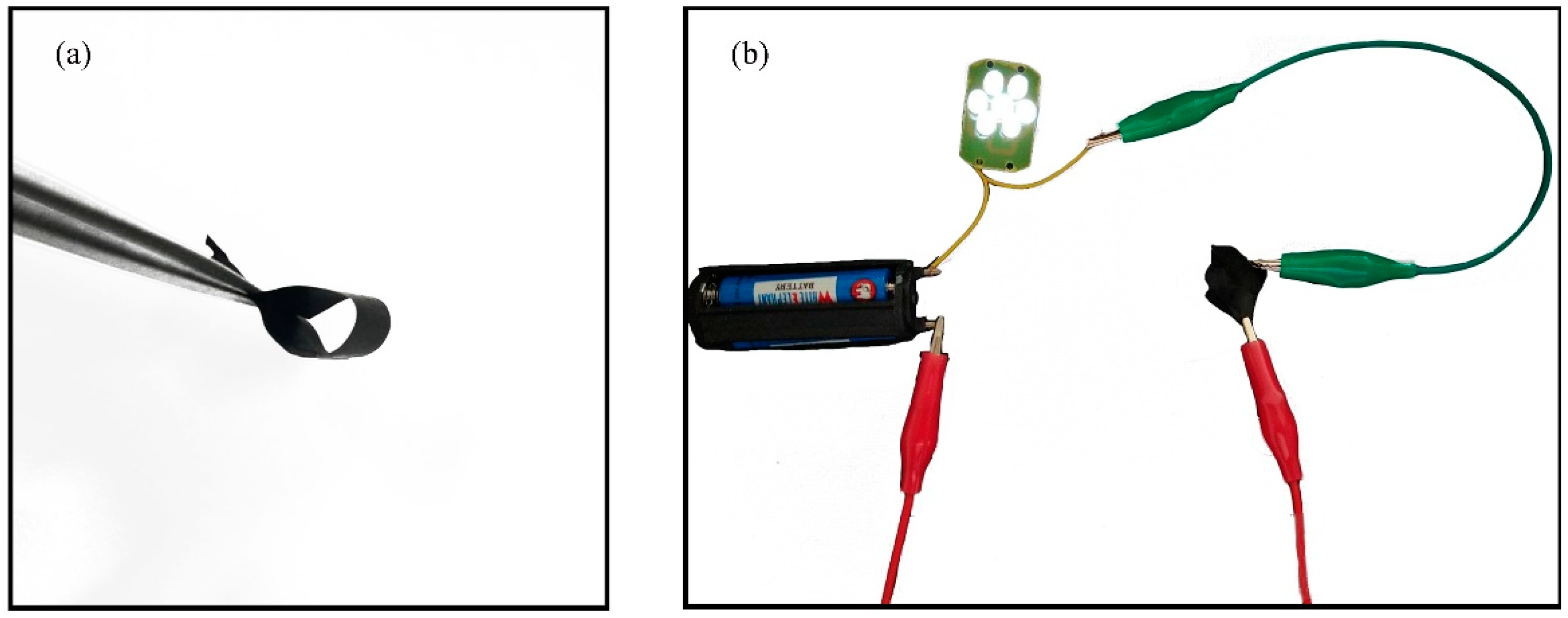
© 2018 by the authors. Licensee MDPI, Basel, Switzerland. This article is an open access article distributed under the terms and conditions of the Creative Commons Attribution (CC BY) license (http://creativecommons.org/licenses/by/4.0/).
Share and Cite
Jin, S.; Yu, J.; Zheng, Y.; Wang, W.-Y.; Xin, B.; Kan, C.-W. Preparation and Characterization of Electrospun PAN/PSA Carbonized Nanofibers: Experiment and Simulation Study. Nanomaterials 2018, 8, 821. https://doi.org/10.3390/nano8100821
Jin S, Yu J, Zheng Y, Wang W-Y, Xin B, Kan C-W. Preparation and Characterization of Electrospun PAN/PSA Carbonized Nanofibers: Experiment and Simulation Study. Nanomaterials. 2018; 8(10):821. https://doi.org/10.3390/nano8100821
Chicago/Turabian StyleJin, Shixin, Jiali Yu, Yuansheng Zheng, Wen-Yi Wang, Binjie Xin, and Chi-Wai Kan. 2018. "Preparation and Characterization of Electrospun PAN/PSA Carbonized Nanofibers: Experiment and Simulation Study" Nanomaterials 8, no. 10: 821. https://doi.org/10.3390/nano8100821
APA StyleJin, S., Yu, J., Zheng, Y., Wang, W.-Y., Xin, B., & Kan, C.-W. (2018). Preparation and Characterization of Electrospun PAN/PSA Carbonized Nanofibers: Experiment and Simulation Study. Nanomaterials, 8(10), 821. https://doi.org/10.3390/nano8100821






